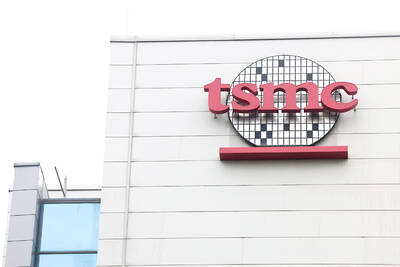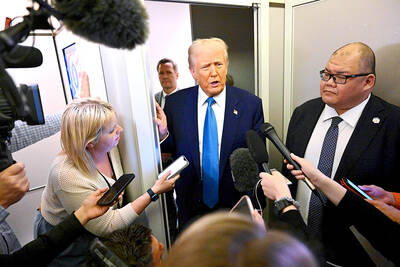Over the past two decades, Gee’s Bend quilts have captured the public’s imagination with their kaleidoscopic colors and their daring geometric patterns. The groundbreaking art practice was cultivated by direct descendants of slaves in rural Alabama who have faced oppression, geographic isolation and intense material constraints.
As of this year, their improvisational art has also come to embody a modern question: What happens when distinctive cultural tradition collides with corporate America?
Enter Target Corp.

Photo: Tangular Irby via AP
The multinational retailer launched a limited-edition collection based on the quilters’ designs for the US’ Black History Month this year. Consumer appetites proved to be high as many stores around the US sold out of the checkered sweaters, water bottles and faux-quilted blankets.
“We’re actually in a quilt revival right now, like in real time,” artist and academic Sharbreon Plummer said. “They’re so popularized, and Target knew that. It created the biggest buzz when it came out.”
Indeed, there has been a resurgence of interest among Gen Z and millennials in conscious consumption and the homemade — with “cottagecore” style, baking bread, DIY bracelets — but both are at odds with the realities of fast fashion.

Photo: AP
The Target designs were “inspired by” five Gee’s Bend quilters who reaped limited financial benefits from the collection’s success. They received a flat rate for their contributions rather than pay proportionate to Target’s sales.
A spokesperson for Target would not share sales numbers from the collection, but confirmed that it sold out in many stores.
Unlike the pay structure of the Freedom Quilting Bee of the 1960s — an artist-run collective that disbursed payment equitably to Gee’s Bend quilters, who were salaried and could set up US Social Security benefits — one-off partnerships with companies like Target benefit only a small number of people, in this case five women from two families.
The maxim “representation matters” is not new, but it is gaining wider traction. Still, when visibility for some does not translate into meaningful change for a marginalized community as a whole, how is that reconciled?
”Every stage of the finances has been problematic,” said Patricia Turner, a retired professor in World Arts and Culture and African American Studies at the University of California, Los Angeles who traced the commodification of Gee’s Bend quilts back to white collector Bill Arnett in the 1990s.
“I’m really bothered by Target’s in-house designer manipulating the look of things to make it more palatable for their audience,” she said of the altered color palettes and patterns.
“Each quilter had the opportunity to provide input on the items featured in our collection on multiple occasions throughout the process,” Target spokesperson Brian Harper-Tibaldo wrote in an e-mailed statement.
While thumbnail-size photographs of the makers appeared on some marketing materials and the text “Gee’s Bend” was printed on clothing tags, the company’s engagement with the quilters was limited. As soon as Black History Month ended, the quilters’ names and images were scrubbed from the retailer’s site.
While Target has pledged to spend more than US$2 billion on black-owned businesses by next year, it has no plans to work again with the Gee’s Bend community.
The situation mirrors that of the 1990s, when some quilters enjoyed newfound visibility, others were disinterested and still others felt taken advantage of. (In 2007, several quilters brought a series of lawsuits against the Arnett family, but all cases were settled out of court and little is known about the suits because of nondisclosure agreements.)
The profit-oriented approach that emerged, which disrupted the Quilting Bee’s price-sharing structure, created “real rifts and disharmony within the community” over engaging with collectors, art institutions and commercial enterprises, Turner said. “To have those bonds disrupted over the commercialization of their art form, I think, is sad.”
By reproducing an aesthetic, but stripping it of its social fabric and familial context, Target missed capturing the essence of what makes this particular craft tradition so rich and distinct.
Quilts are made to mark major milestones and are gifted to celebrate a new baby or a marriage, or to honor someone’s loss. Repurposing fabric — from tattered blankets, frayed rags, stained clothes — is a central ethos of the community’s quilting practice, which resists commodification.
However, the Target collection was mass-produced from new fabrics in factories in China and elsewhere overseas.
The older generations of Gee’s Bend quilters are known for one-of-a-kind designs with clashing colors and irregular, wavy lines — visual effects borne of their material constraints. Most worked at night in houses without electricity and did not have basic tools such as scissors, let alone access to fabric stores.
Stella Mae Pettway, who has sold her quilts on Etsy for US$100 to US$8,000, has characterized having scissors and access to more fabrics now as a paradox of “advantage and a disadvantage.”
Many third and fourth-generation artists returned to quilting as adults for a creative and therapeutic outlet, as well as a tether to their roots.
After her mom died in 2010, quilter JoeAnn Pettway-West revisited the practice and found peace in completing her mother’s unfinished quilts.
“As I’m making this stitch, I can just see her hand, stitching. It’s like, we’re there together,” she said. “It’s a little bit of her, a little bit of me.”
Delia Pettway Thibodeaux is a third-generation Gee’s Bend quilter whose grandmother was a sharecropper and whose bold, rhythmic quilts are in the Philadelphia Museum of Art’s permanent collection.
For the Target collection, she received a flat fee rather than a rate proportional to sales.
“I was kind of concerned in the beginning” about how quilts would be altered to fit with the collection, Pettway Thibodeaux said. “But then again when I saw the collection, I felt different.”
Because job opportunities are so limited in Gee’s Bend, many fourth-generation quilters have left the area to take jobs as teachers, day care workers or home health aides, or to serve in the military.
“We, as the next generation, we was more dreamers,” Pettway-West said.
National recognition has certainly brought some positive change, but more visibility — from museum exhibitions, academic research and a US Postal Service stamp collection — has not necessarily translated into economic gains.
After all, the average annual income in Boykin, Alabama, is still far below the poverty rate at about US$12,000, according to the nonprofit Nest.
“This is a community that still, to this day, really needs recognition, still needs economic revitalization,” said Lauren Cross, Gail-Oxford Associate Curator of American Decorative Arts at The Huntington Museum of Art. “And so any economic opportunities that, you know, funnel back to them, I support.”
Target’s line in particular is disconnected from the group’s origins and handmade practice, she said.
It is a problem that distills the challenge at hand when something handcrafted and linked to deep tradition goes national and corporate.
“On one hand you want to preserve the stories and that sense of authenticity,” Cross said. “And on the other hand, how do you reach a broader audience?”

When an apartment comes up for rent in Germany’s big cities, hundreds of prospective tenants often queue down the street to view it, but the acute shortage of affordable housing is getting scant attention ahead of today’s snap general election. “Housing is one of the main problems for people, but nobody talks about it, nobody takes it seriously,” said Andreas Ibel, president of Build Europe, an association representing housing developers. Migration and the sluggish economy top the list of voters’ concerns, but analysts say housing policy fails to break through as returns on investment take time to register, making the

NOT TO WORRY: Some people are concerned funds might continue moving out of the country, but the central bank said financial account outflows are not unusual in Taiwan Taiwan’s outbound investments hit a new high last year due to investments made by contract chipmaker Taiwan Semiconductor Manufacturing Co (TSMC, 台積電) and other major manufacturers to boost global expansion, the central bank said on Thursday. The net increase in outbound investments last year reached a record US$21.05 billion, while the net increase in outbound investments by Taiwanese residents reached a record US$31.98 billion, central bank data showed. Chen Fei-wen (陳斐紋), deputy director of the central bank’s Department of Economic Research, said the increase was largely due to TSMC’s efforts to expand production in the US and Japan. Investments by Vanguard International

WARNING SHOT: The US president has threatened to impose 25 percent tariffs on all imported vehicles, and similar or higher duties on pharmaceuticals and semiconductors US President Donald Trump on Wednesday suggested that a trade deal with China was “possible” — a key target in the US leader’s tariffs policy. The US in 2020 had already agreed to “a great trade deal with China” and a new deal was “possible,” Trump said. Trump said he expected Chinese President Xi Jinping (習近平) to visit the US, without giving a timeline for his trip. Trump also said that he was talking to China about TikTok, as the US seeks to broker a sale of the popular app owned by Chinese firm ByteDance Ltd (字節跳動). Trump last week said that he had

STRUGGLING TO SURVIVE: The group is proposing a consortium of investors, with Tesla as the largest backer, and possibly a minority investment by Hon Hai Precision Nissan Motor Co shares jumped after the Financial Times reported that a high-level Japanese group has drawn up plans to seek investment from Elon Musk’s Tesla Inc to aid the struggling automaker. The group believes the electric vehicle (EV) maker is interested in acquiring Nissan’s plants in the US, the newspaper reported, citing people it did not identify. The proposal envisions a consortium of investors, with Tesla as the largest backer, but also includes the possibility of a minority investment by Hon Hai Precision Industry Co (鴻海精密) to prevent a full takeover by the Apple supplier, the report said. The group is